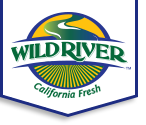OGC - Get to know our friends at Wild River
Organically Grown Company
We’re in that fuzzy time period between winter and spring, making it the perfect time to celebrate our favorite fuzzy fruit – kiwis! Kiwi’s bright green or yellow-gold flesh, teensy black seeds, and brown skin make these oblong orbs both fun and visual stunners. They are abundant now and ready to roll into your organic set from the Noland family at Wild River Fruit in Marysville, California.
For more than five decades, the Nolands have farmed alongside the Yuba River, working with the rhythms of the water and land to take advantage of the highly fertile, nutrient-rich topsoil resulting from the river’s overflow. Their hands-on approach to managing their kiwi vineyard includes designing a state-of-the-art irrigation system, planting, pruning and harvesting the fruit.
“We like to say we farm the Wild River way, which means in conjunction with nature and that all of our offices and packing houses are up on stilts, 8-feet off the ground!” said Travis Noland, the family’s third-generation to farm the land. “We operate right along the undamned Yuba River in the natural riparian habitat. In the long run, the Yuba River floods result in a fresh layer of topsoil and make for a fertile, loamy soil that’s unique to us and makes our kiwi and other fruits so high quality.”
Over the past five years, when the Nolands would loose older kiwi vines, Michael Noland, Travis’ father, started to experiment with inter-cropping and planted Fuyu persimmons within the kiwi vineyard. Now, there are blocks on the farm where Fuyus are thriving among blocks of kiwis and pluots, and they can all be harvested together.
It’s the season for Green and Gold Kiwifruit
OGC carries two organically grown varieties from Wild River Fruit, the Hayward – the most popular green variety, known for their large size and sugar content, and the Tropkiwi (or Gold) — which has a smooth, bronze skin and an internal flesh that varies in color from light green to golden yellow.
The golden kiwifruit variety is new to the U.S. and has only been grown successfully over for the past 5-8 years. Wild River was the first to cultivate this variety using shade cloth, which helps control the climate by filtering the sun’s intense heat in the summer and protecting the vines from frost in the winter, mimicking the fruit’s native moist New Zealand growing conditions.
The gold kiwi is lower in acid compared to a green kiwi with a less tart, slightly tropical, sweet flavor that is especially popular among children. It also has less fuzz, which makes it easy to eat without peeling.
When perfectly ripe, kiwi tastes like a smoothie; part banana, strawberry, and melon with a tropical twist. This sweet, juicy fruit is nutritional powerhouse. And with the public’s heightened interest in wellness, there’s no better time to promote organic kiwi and educate eaters about this beautiful superfood:
Kiwifruit packs more nutrients per ounce than 27 other commonly consumed fruits, including oranges, bananas, and apples
Kiwifruit has the highest level of vitamin C – almost twice that of an orange! Gold kiwis are an even better source
They’re full of nutrients like vitamin K, vitamin E, folate, copper, and potassium
They’re rich in antioxidants and a good source of fiber
Eating two of the fruits one hour before bedtime could help people nod off quickly and sleep more soundly, scientists say. It is not understood why, but it could be linked to high antioxidant and serotonin levels in the fruit
Kiwifruit is native to China, which considers this berry its national fruit. Europeans originally called it “Chinese gooseberry” and farmers started growing this fruit commercially about a century ago in New Zealand. That’s where American servicemen first tasted the fruit, and they helped popularize it in the United States after World War II. First importing it in 1962, the legendary California produce pioneer Frieda Caplan gets credit for introducing millions of Americans to “kiwifruit” under that name.

